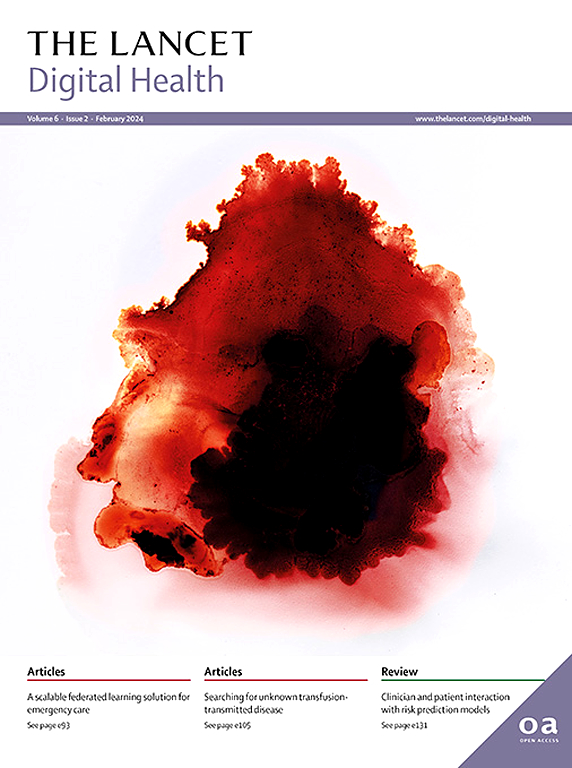AI-based volumetric six-tissue body composition quantification from CT cardiac attenuation scans for mortality prediction: a multicentre study
IF 24.1
1区 医学
Q1 MEDICAL INFORMATICS
引用次数: 0
Abstract
Background
CT attenuation correction (CTAC) scans are routinely obtained during cardiac perfusion imaging, but currently only used for attenuation correction and visual calcium estimation. We aimed to develop a novel artificial intelligence (AI)-based approach to obtain volumetric measurements of chest body composition from CTAC scans and to evaluate these measures for all-cause mortality risk stratification.
Methods
We applied AI-based segmentation and image-processing techniques on CTAC scans from a large international image-based registry at four sites (Yale University, University of Calgary, Columbia University, and University of Ottawa), to define the chest rib cage and multiple tissues. Volumetric measures of bone, skeletal muscle, subcutaneous adipose tissue, intramuscular adipose tissue (IMAT), visceral adipose tissue (VAT), and epicardial adipose tissue (EAT) were quantified between automatically identified T5 and T11 vertebrae. The independent prognostic value of volumetric attenuation and indexed volumes were evaluated for predicting all-cause mortality, adjusting for established risk factors and 18 other body composition measures via Cox regression models and Kaplan-Meier curves.
Findings
The end-to-end processing time was less than 2 min per scan with no user interaction. Between 2009 and 2021, we included 11 305 participants from four sites participating in the REFINE SPECT registry, who underwent single-photon emission computed tomography cardiac scans. After excluding patients who had incomplete T5–T11 scan coverage, missing clinical data, or who had been used for EAT model training, the final study group comprised 9918 patients. 5451 (55%) of 9918 participants were male and 4467 (45%) of 9918 participants were female. Median follow-up time was 2·48 years (IQR 1·46−3·65), during which 610 (6%) patients died. High VAT, EAT, and IMAT attenuation were associated with an increased all-cause mortality risk (adjusted hazard ratio 2·39, 95% CI 1·92–2·96; p<0·0001, 1·55, 1·26–1·90; p<0·0001, and 1·30, 1·06–1·60; p=0·012, respectively). Patients with high bone attenuation were at reduced risk of death (0·77, 0·62–0·95; p=0·016). Likewise, high skeletal muscle volume index was associated with a reduced risk of death (0·56, 0·44–0·71; p<0·0001).
Interpretation
CTAC scans obtained routinely during cardiac perfusion imaging contain important volumetric body composition biomarkers that can be automatically measured and offer important additional prognostic value.
Funding
The National Heart, Lung, and Blood Institute, National Institutes of Health.
基于人工智能的CT心脏衰减扫描的六组织体积组成量化用于死亡率预测:一项多中心研究。
背景:CT衰减校正(CTAC)扫描在心脏灌注成像中是常规的,但目前仅用于衰减校正和视觉钙估计。我们的目标是开发一种新的基于人工智能(AI)的方法,从CTAC扫描中获得胸体成分的体积测量,并评估这些测量方法对全因死亡率风险分层的影响。方法:我们对来自四个地点(耶鲁大学、卡尔加里大学、哥伦比亚大学和渥太华大学)的大型国际图像注册中心的CTAC扫描应用基于人工智能的分割和图像处理技术,以定义胸廓和多个组织。对自动识别的T5和T11椎体间的骨、骨骼肌、皮下脂肪组织、肌内脂肪组织(IMAT)、内脏脂肪组织(VAT)和心外膜脂肪组织(EAT)的体积测量进行量化。通过Cox回归模型和Kaplan-Meier曲线,评估体积衰减和指数体积的独立预后价值,以预测全因死亡率,调整已确定的危险因素和其他18种身体成分测量。发现:端到端处理时间每次扫描不到2分钟,没有用户交互。2009年至2021年间,我们纳入了来自四个地点的11,305名参与者,他们参加了REFINE SPECT登记,接受了单光子发射计算机断层扫描心脏扫描。在排除T5-T11扫描覆盖不全、缺少临床数据或曾用于EAT模型训练的患者后,最终研究组包括9918例患者。9918名参与者中男性5451人(55%),女性4467人(45%)。中位随访时间为2.48年(IQR为1.46 ~ 3.65),随访期间死亡610例(6%)。高VAT、EAT和IMAT衰减与全因死亡风险增加相关(校正风险比2.39,95% CI 1.92 - 2.96;解释:在心脏灌注成像期间常规获得的CTAC扫描包含重要的体积体组成生物标志物,可以自动测量并提供重要的附加预后价值。资助:国家心脏,肺和血液研究所,国家卫生研究院。
本文章由计算机程序翻译,如有差异,请以英文原文为准。
求助全文
约1分钟内获得全文
求助全文
来源期刊

Lancet Digital Health
Multiple-
CiteScore
41.20
自引率
1.60%
发文量
232
审稿时长
13 weeks
期刊介绍:
The Lancet Digital Health publishes important, innovative, and practice-changing research on any topic connected with digital technology in clinical medicine, public health, and global health.
The journal’s open access content crosses subject boundaries, building bridges between health professionals and researchers.By bringing together the most important advances in this multidisciplinary field,The Lancet Digital Health is the most prominent publishing venue in digital health.
We publish a range of content types including Articles,Review, Comment, and Correspondence, contributing to promoting digital technologies in health practice worldwide.
 求助内容:
求助内容: 应助结果提醒方式:
应助结果提醒方式:


